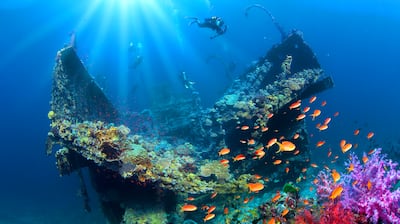As Saudi Arabia celebrates its 91st National Day, under the theme "A Home for Us", the kingdom is also gearing up for the return of international visitors now that travel restrictions have started to ease.
Tourists have been able to travel to Saudi Arabia since August, when the kingdom opened up to vaccinated visitors from 17 countries. This month, travel between the UAE and Saudi Arabia also resumed after a 17-month closure, with immunised tourists now able to visit.
Spanning some 2.15 million square kilometres, the country has a wide variety of things to see, places to visit and landscapes to wander. Should its national day celebrations pique your interest, here are some of Saudi Arabia's must-try experiences to add to your bucket list if a trip to the kingdom is on your radar.
1. Hike to the Edge of the World

Located about a 90-minute drive from Riyadh, Jebel Fihrayn or The Edge of the World, is one of the best spots in the entire kingdom for scenic views that will leave a lasting impression.
Forming part of the vast Tuwaiq cliffs, which stretch more than 600 kilometres through central Saudi Arabia, this destination guarantees you a picture-perfect moment and a feeling of insignificance as you stand next to the unending landscape.
Go early in the morning to see the sunrise over the canyons and avoid the crowds that flock to what has fast become one of the capital’s most popular tourist sites.
2. Explore Taif’s Rose Gardens

Perfume fans will want to schedule a trip to Taif. This historic city is famed for its rose gardens and is the main exporter of perfume in the Arab world. The region’s mild weather and mountainous landscapes allow beautifully scented roses to grow in abundance.
Known as 'taifi" flowers, they are used to make a very distinct perfume that's highly sought after. Their by-products are cultivated for rosewater and oil. Visit in spring to see more than 900 rose farms begin to harvest some 300 million flowers.
And don’t miss a stop at Al Rudaf Park, which transforms into a rose village every year with sections carpeted in the blooms and enjoy local songs, dances, plays and performances devoted to roses.
3. Go Stargazing at Moon Mountain

Take advantage of the dark skies and endless desert on the outskirts of Jeddah, the perfect setting for stargazers.
Located about an hour from Saudi Arabia's second-largest city is Moon Mountain, named after its lunar-like landscape that's filled with jagged rock formations, pitted dunes and craggy outcrops. Part of the Jebel Al Jadib mountain range, this is the ideal place for camping and getting set to enjoy a night under a dizzying blanket of stars.
The jet-black skies and solitude of the sands here draw travellers from across the country, and when day breaks, there's hiking, quad biking and other desert adventures to keep you entertained.
4. Head underwater in the Red Sea

Saudi Arabia's underwater kingdom lays claim to some of the best diving in the world, and it's all largely undiscovered. The Red Sea is home to more than 1,200 species of fish, several of which can only be found in this body of water, meaning divers can expect never-seen-before adventures.
Spinner dolphins, dugongs, turtles, mantas and sharks are just some of the marine species that also call these waters home. And with underwater tourism in the kingdom in its infancy, scuba divers can expect uncrowded waters and a pristine sandy seabed when it comes to exploring Saudi Arabia's dramatic marine life.
5. Go island-hopping in Umluj

If you want to feel like you’re in a tropical paradise, then Saudi Arabia’s Umluj, in the northern Tabuk province, is the place to go. This coastal town is home to swaying palm trees and untouched stretches of shoreline, plus plenty of casual cafes and restaurants.
But the real draw of this region are the 100-plus small islands to the north of the town. Hire a boat, pack your swimwear and go explore the pure white sand, clear waters and splendid isolation.
6. Step back in time at Al Balad

Jeddah’s Al Balad is famous for its intricately designed houses that were built using coral from the depths of the Red Sea. The buildings have colourful rawasheen balconies, known as mashrabiyas, and the entire district is a Unesco World Heritage Site.
Wandering through the maze-like streets, you'll soon get a feel for what the medieval city’s ancient walls once looked like. The unique architecture, which is still preserved today, is not seen anywhere else in the world and serves as a reminder of what life used to be like. It’s believed that the town may date back to the era before Islam.
7. Journey to the past in Al Ula
Deep in the desert in the north-west of the country is Al Ula, a vast 22,000 square kilometre territory that was once a major hub along the ancient Incense Route connecting the Arabian Peninsula with Mediterranean countries.
This is where visitors will find Hegra, Saudi Arabia’s first Unesco World Heritage Site and the largest conserved site of Nabataean civilisation outside of Petra. Unlike in Jordan, in Al Ula, tourists have the sandstone rocks largely to themselves as the district remains well off the tourism trail.
Al Ula is also home to Elephant Rock. Towering about 52 metres above the ground, this ancient rock has been sculpted by wind, water and sand over millions of years, shaping it into a mammoth sandstone structure that now quite clearly resembles an elephant standing with its trunk on the ground.
And adding to Al Ula's draw as an outdoor museum is Jabal Ikmah, a place that's been called the country’s largest open-air library, thanks to the hundreds of pre-Arabic inscriptions scrawled on the rocks.





















